9 Top Fintech Marketing Trends and Tips for 2024
- Home
- Intelligent Insights Blog
- 9 Top Fintech Marketing Trends and Tips for 2024
Fintech is a growing industry with a surge of new startups emerging worldwide. So, if you operate a fintech company, you know marketing comes with a slew of challenges.
Out of the gate, you’re dealing with a high rate of competition. If you’re struggling to differentiate yourself and communicate your unique value, you’re not alone.
Next, trust is a critical factor in financial services. As a fintech company, you may face skepticism from consumers who are concerned about their personal and financial data. Building and maintaining trust through marketing is a constant challenge.
Lastly, many fintech products and services require a high level of education. Potential customers must understand their benefits and how to use them. Your fintech marketing efforts should simplify complex financial concepts while avoiding oversimplification.
If you’re not sure where to begin, don’t panic.
We’ve outlined 9 of the most relevant fintech marketing trends and ideas. These trends can help take your fintech marketing efforts to a level previously unimagined.
So, delve into these 9 trends and learn how to make them a part of your strategy.
Ready to boost your fintech PR and marketing strategies?
Let us help! Book a free consultation with one of our PR and marketing experts. We will take a look at your current strategies to see where they could best benefit from a boost.
Our 9 Top Fintech Marketing Trends
- Public Relations
- Thought Leadership
- Influencer Marketing
- AI and Automation
- Short-Form Video
- Experiential Marketing
- Educational Content
- B2B Marketing
- Community Marketing
1. Public Relations is Getting Fintech Brands Noticed
Public relations (PR) ensures that your fintech brand doesn’t go unnoticed.
Fintech companies use PR to build and maintain a positive brand image, establish credibility, and enhance trust in their services. That’s what makes it one of the top fintech marketing trends.
PR also helps you navigate complex regulatory landscapes, respond to crises, and promote your innovations. This, in turn, helps you attract and retain customers, secure investments, and foster relationships with key industry players.
To leverage PR, consider forming strategic partnerships with complementary fintech firms, traditional financial institutions, or industry influencers. Be sure to showcase the mutual benefits of these partnerships to both the public and potential investors.
Given the stringent regulations in the fintech industry, it’s also important to address regulatory issues. You should ensure compliance and create comms and content that reflect your commitment to following all relevant rules and standards.
Finally, be sure to build long-lasting relationships with relevant journalists and publications in your industry. Remember to only pitch newsworthy information like your strategic partnerships or original thought leadership content.
Remember that press releases aren’t the full spectrum of PR. Use them sparingly and only when you have the most vital information to communicate.
This press release is an example of what PR looks like in fintech marketing:
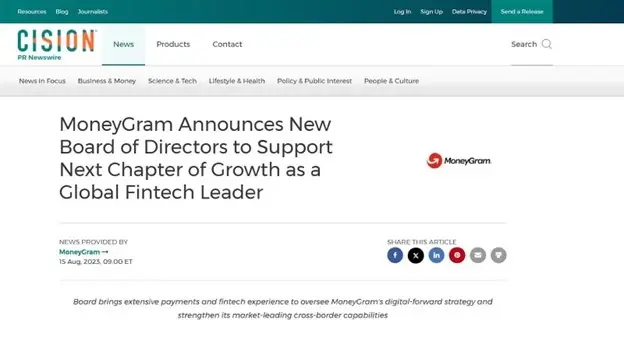
Pro Tip: Develop a robust crisis management plan in advance. This will help you promptly address any negative publicity or unforeseen challenges. More specifically, prepare yourself to respond to data breaches, service interruptions, or regulatory investigations.
To get a better idea of how PR can work in fintech marketing, see our comprehensive guide: How to Write an Effective PR Plan [Tips + Examples]
2. Thought Leadership Can Show Your Expertise in the Fintech Industry
Want to become a fintech guru?
Thought leadership is one of the leading fintech marketing trends for a reason. It’s key to showcasing your expertise in the fintech industry. This can come in the form of insights and forward-thinking ideas communicated through content, research, and public speaking.
Establishing thought leadership in fintech builds credibility and trust with your target audience. It also positions your fintech brand as a reliable source of industry knowledge.
To be a thought leader in fintech, it’s crucial to stay up-to-date with the latest industry trends, emerging technologies, and regulatory changes. Continuously innovate and provide fresh insights to establish yourself as an authority in the ever-evolving fintech landscape.
Develop and share high-quality content that offers valuable insights and solutions. These can include blog posts, whitepapers, research reports, and webinars.
This article found on Forbes is an example of how thought leadership is used in fintech:
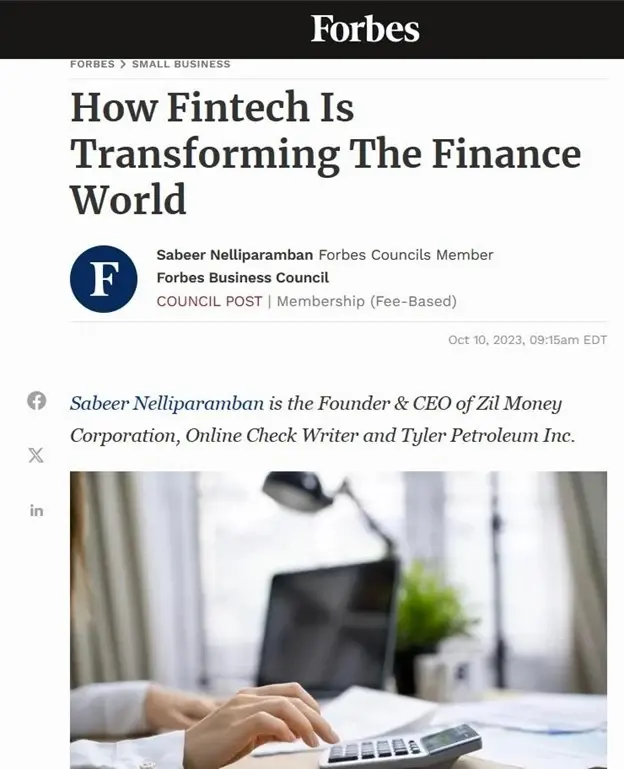
Pro Tip: Collaborate with other industry leaders, fintech companies, and relevant organizations. Build partnerships and networks to expand your knowledge and reach a wider audience.
To learn how to leverage thought leadership, check out our guide: Unlocking the Power of Thought Leadership Marketing (Benefits + Best Practices)
3. Influencer Marketing is Boosting Engagement Rates
Sometimes fintech marketing isn’t just about what you know, but who you know. That’s where influencers come in.
Why is influencer marketing one of the top fintech marketing trends? It has helped fintech companies reach an engagement rate of 126%.
Influencer marketing helps you tap into the influencer’s established audience. This extends your fintech product or service’s reach to a wider and more engaged customer base.
When working with influencers, select the ones whose expertise and audience align with your fintech product or service. Consider working with micro-influencers who have smaller but highly engaged and niche audiences.
Also, foster authentic relationships with influencers by engaging with their content. You can also collaborate on campaigns that resonate with their audience.
Believe it or not, many influencers create content within the fintech niche. Here is one of them:
Pro Tip: Use tracking and analytics tools to measure the impact of influencer campaigns. Focus on key performance indicators such as engagement, conversions, and brand sentiment.
Need some influencer marketing ideas? Check out our article: 9 Top Influencer Marketing Trends Shaping the Industry in 2024
4. AI and Automation Handles a Variety of Fintech Tasks
What makes artificial intelligence (AI) one of the most innovative fintech marketing trends? AI in fintech has led to improved efficiency, accuracy, and speed in operations.
In fact, marketers across industries are finding that AI improves their results, causing more than 61% of marketers to adopt it as part of their strategies.
AI functions can include data collection, fraud detection, customer service, content creation, and more.
AI and automation can manage a variety of tasks and free up time and resources. When it comes to fintech marking, it can help you deliver personalized content based on customer data.
Leverage AI and automation to tailor marketing messages, offers, and content to individual customer preferences, increasing engagement and conversion rates.
Ensure your AI and automation strategies comply with data protection regulations. This will help you build trust with customers concerned about data privacy.
Additionally, try using AI to set up chatbots on your fintech website. This allows you to provide automated customer support 24/7.
Cleo is an example of a fintech product with built-in AI. You don’t have to limit your use of AI to your marketing and PR. Have a look:
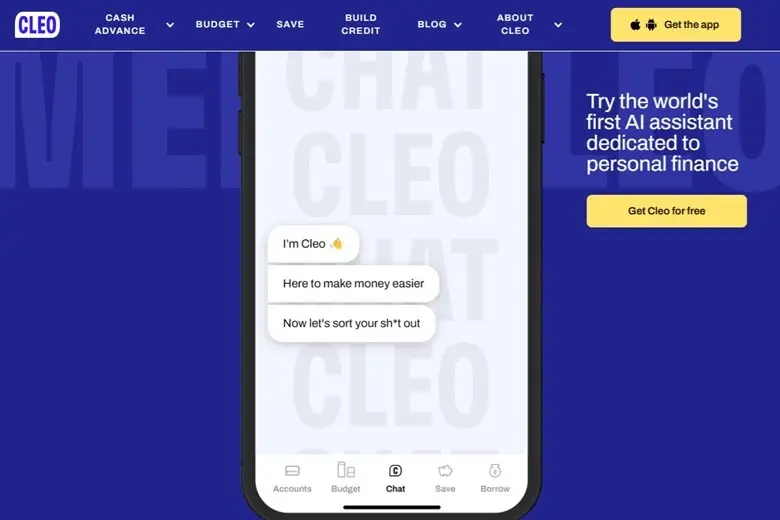
Pro Tip: Like Cleo, many products and apps now come with built-in AI. So, if you want an easy way to use AI, look for tools and products that already include it. For example, Intelligent Relations has Preston, an AI that curates relevant journalists, publications, and trending topics for you all while generating a first draft PR pitch.
Interested in other marketing automation trends? Then you’ll want to check out our dedicated article: 10 Emerging Marketing Automation Trends for 2024
5. Short-Form Video is the Go-To for Fintech Consumers
With attention spans shortening, short-form video is taking over the Internet. According to a recent poll, 75% of participants believe that short-form video is the future of content marketing.
It doesn’t matter your industry, short-form video can be your brand’s 15 seconds of fame, making it an important fintech marketing trend.
That’s because short-form videos capture and maintain audience attention. Plus, their shareability often leads to viral reach, which boosts brand visibility and engagement.
To benefit from this trend, craft concise, attention-grabbing videos with a clear message. Focus on engaging storytelling and visual appeal to capture viewers’ attention quickly.
Tailor your short-form videos to the specific platform you’re using (e.g., TikTok, Instagram, Reels). This ensures that your videos align with the platform’s style and audience.
Here is an example of how short-form video is used in fintech marketing:
Pro Tip: Regularly post short-form videos to maintain audience engagement and visibility. You can accomplish this by establishing a content schedule that suits your audience’s habits.
Want to add short-form video to your fintech marketing strategy? See our article: Top 10 Video Marketing Trends for 2024 [+ Tips]
6. Experiential Marketing is Gaining Traction in the Fintech Industry
Many consumers today don’t just want to be fintech customers. They want to join the show.
That’s why experiential marketing is among the leading fintech marketing trends. In fact, experiential marketing is quickly gaining traction across all industries.
Experiential marketing creates memorable, immersive experiences. These experiences can leave a lasting impact on your audience. It can also foster brand loyalty and word-of-mouth promotion.
To make experiential marketing work for you, try organizing virtual or in-person events. These events should provide immersive, interactive experiences for your audience to engage with your fintech offerings.
Weave compelling narratives around your product or service to create emotional connections and memorable experiences. Also, collect and act on feedback to refine future events and campaigns.
The Singapore Fintech Festival is an example of how to use experiential marketing. See the video below to learn more about this event:
Pro Tip: Extend the reach of experiential marketing by integrating it with other channels. This can include social media, email, and content marketing.
7. Fintech Customers Prefer Educational Content
Who says learning about finance can’t be fun and engaging? If you want to keep the customers and viewers coming back, offer educational content.
Studies show that consumers are 131% more likely to become customers after exposure to educational content, making it one of the top fintech marketing trends.
Educational content positions your fintech company as an industry authority. It also empowers customers with valuable knowledge and solutions to their financial challenges.
Create content that addresses common challenges and questions your target audience. This can be video, blogs, white papers, infographics, eBooks, or webinars.
Keep educational content up-to-date to ensure accuracy and relevance. Show your commitment to providing the latest insights and knowledge.
Here is an example from Chime on how to use educational content in fintech:

Pro Tip: Educational content doesn’t have to be FAQs. It can include anything that educates your audience on the broader topics related to your product or service. You can enhance educational content by incorporating quizzes, surveys, and interactive elements. Use these interactive elements to engage your audience and encourage active participation.
Need tips on how to leverage content marketing? Check out our article: 7 Top Content Marketing Trends 2024 [+ Tips and Tricks]
8. Fintech Companies Are Finding Customers in the B2B Market
Why is B2B marketing one of the most important fintech marketing trends? Because consumers aren’t your only potential customers.
B2B marketing allows you to focus on specific high-value clients and decision-makers. It allows you to nurture relationships and increase the likelihood of successful partnerships and conversions.
Plus, B2B marketing allows you to employ a variety of strategies. Some of the most popular B2B marketing strategies include AI, video marketing, influencer marketing, and personalization.
Focus on building trust and credibility through case studies and testimonials. This type of content should demonstrate the value of your fintech solution.
Also, implement lead nurturing strategies to guide potential B2B customers through the decision-making process. This can include email marketing and targeted content.
Here is an example of B2B marketing in fintech from Stripe:
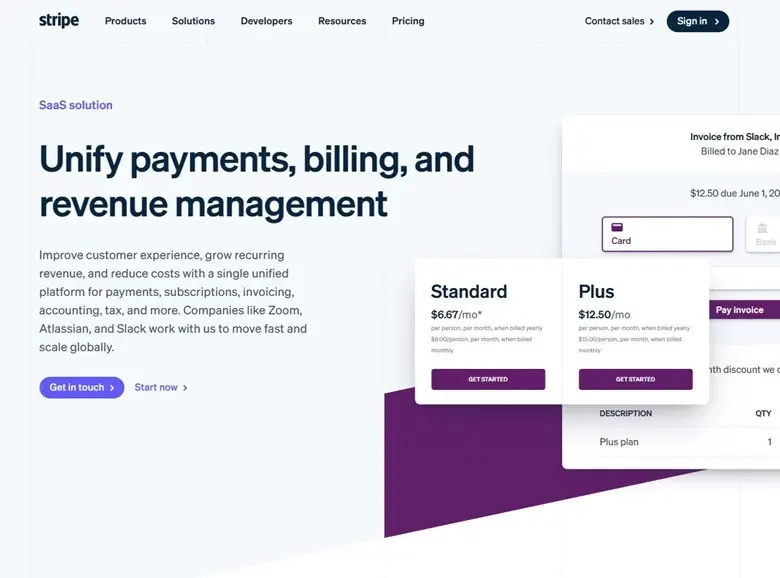
Pro Tip: Use account-based marketing to personalize your approach to high-value B2B clients. Account based marketing is about pinpointing a targeted set of clients in a specific market. The next step is about tailoring your content and outreach to meet their specific needs as a group.
Get some B2B marketing ideas for your fintech strategy by reading our article: 9 B2B Marketing Trends to Follow for Success in 2024
9. Community Marketing Helps You Connect With Consumers
What do you get when you combine fintech enthusiasts, a pinch of social media, and a dash of brand loyalty? It’s the recipe for community marketing, one of the best fintech marketing trends today.
Building a community around your fintech brand fosters customer loyalty. It also engages your customers and encourages them to become brand advocates. This helps drive positive word-of-mouth marketing and referrals.
Build and maintain online communities on social media, forums, or dedicated websites. This should be on channels where members can engage and share experiences related to your fintech products.
Monitor and respond to community discussions, feedback, and concerns promptly. Show that you value and prioritize your customers’ voices.
Also, offer community members exclusive access, discounts, or perks to incentivize participation and loyalty within the community.
Need an example of how community marketing works? Consumers International has offered several fintech workshops for consumers, including those involving consumer empowerment and advocacy:
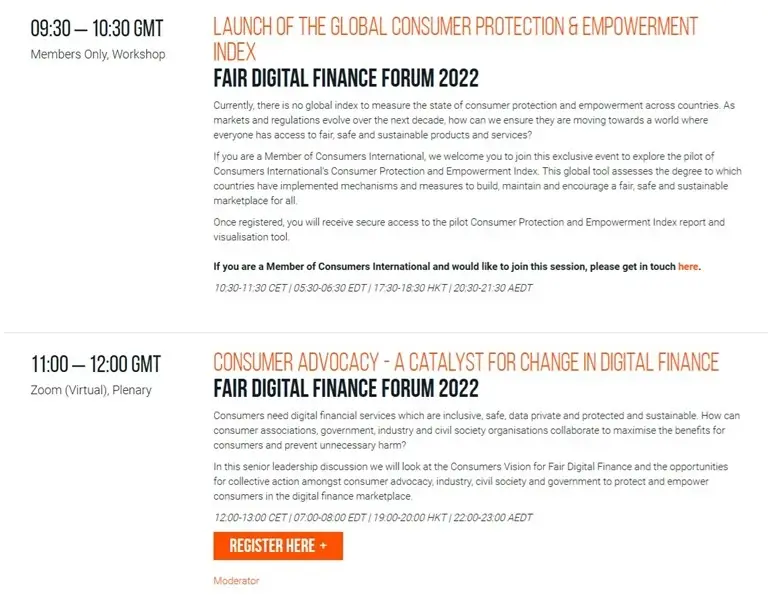
Pro Tip: Encourage your audience to create and share user-generated content. This can include reviews and success stories to showcase the positive impact of your fintech solutions.
Key Takeaways on the Latest Fintech Marketing Trends
The fintech industry is competitive, with new players entering the market regularly. Staying current on the latest fintech marketing trends allows you to adopt innovative strategies that help you stand out and attract new customers.
Plus, adopting innovative fintech marketing ideas ensures that your efforts align with the preferences of your target audience. It allows you to engage and resonate with your customers more effectively. This demonstrates that your fintech company is in tune with their needs.
While the fintech industry is booming, marketing in this sector is no easy task. But following and adopting these marketing trends can help you drive better results.
Think your fintech marketing and PR strategy could use some restructuring? Let us help! Simply book a free consultation to get expert insight into how to improve your efforts for better results.

